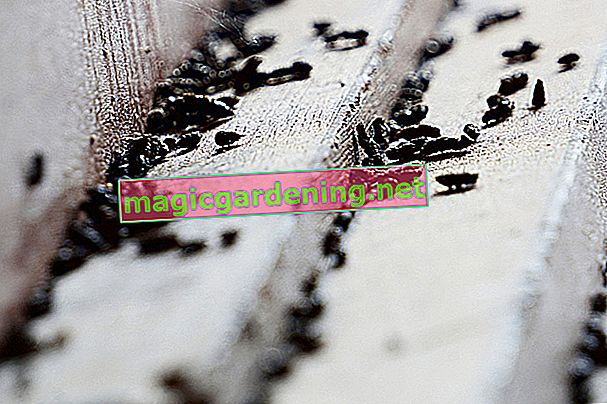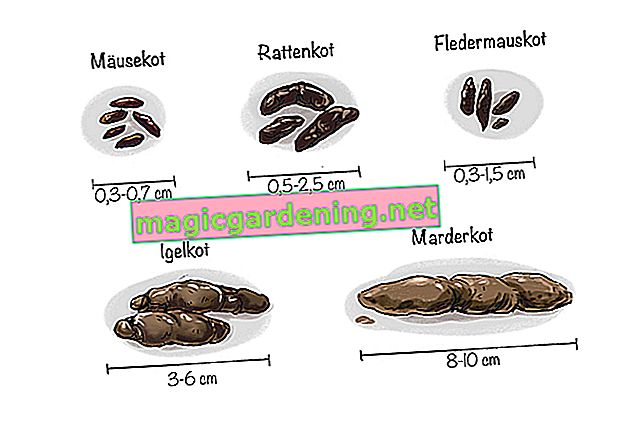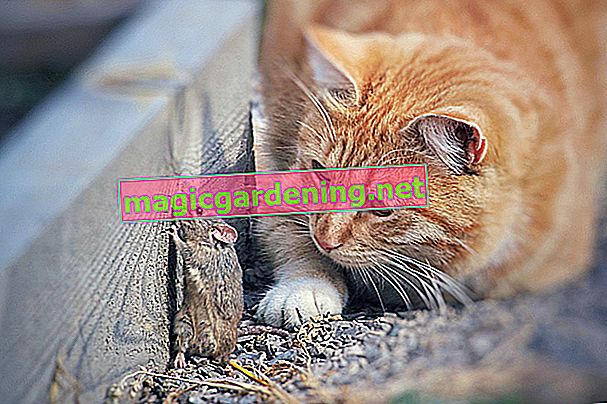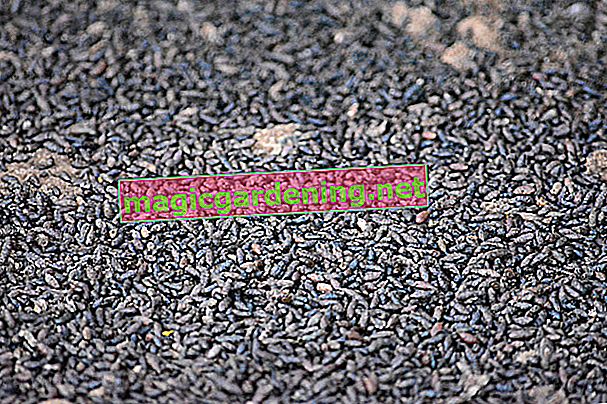
the essentials in brief
- Mouse droppings are harmful because they can contain hantaviruses and other pathogens.
- Mouse droppings can be recognized as 3-7 mm small, dark brown droppings with a strong odor of urine.
- To properly remove mouse feces, a respirator, disposable gloves and disinfectant are essential.
Source of danger mouse excrement - hantavirus lurks

Mice can carry the hantavirus. As so-called reservoir hosts, the rodents excrete the dangerous pathogen in urine, feces and saliva. This fact makes mouse droppings in the house and garden a ticking time bomb for health. Every year in Germany, numerous people fall ill with a hantavirus infection because they came into unprotected contact with the excretions. A mouse problem indoors or outdoors should therefore not be taken lightly.
also read
- The effect of red currants on health
- Lichen indicate health of the fruit tree
- Leaves of the magnolia indicate the health of the plant
For informed people, the source of danger, mouse droppings, is no longer terrifying. In the following, read what the hantavirus is all about, how to recognize and properly remove mouse excrement. Finally, please take a look at some useful tips for effective measures to prevent mouse poop disease.
Hantavirus - 10 questions & 10 answers
The close connection between mouse feces and hantavirus raises important questions. Since the coronavirus pandemic at the latest, we have been sensitized to the dangers that the invisible enemy poses to our health. The following 10 questions with regard to hantaviruses receive an answer suitable for everyday use:
How harmful is the hantavirus?

Hantaviruses are widespread around the world in numerous and very different types. The two virus types Puumala and Dobrava-Belgrade occur in Germany, with the Puumala virus having by far the largest proportion of reported diseases. In contrast to the dreaded South American virus strains, the course of the disease in European hantaviruses is comparatively harmless.
In 2012 there was a fatal outbreak of hantavirus infections in Yosemite National Park in the USA. At least nine visitors contracted HPS (hantavirus-induced pulmonary syndron); three of them died. HPS is caused by hantaviruses that occur exclusively in North America. This virus type, known as Sin Nombre Virus, is much more dangerous than central European hantavirus types and manifests itself in a different clinical picture.
Due to flu-like symptoms, an infection with hantaviruses is often not recognized as such in Germany because there are no severe symptoms. Those who suffer struggle with health restrictions for a while and then go back to business in a healthy and lively manner. Consequential damage to health is not to be feared. Experts from the Robert Koch Institute assume that after infection, the person affected is immune to the specific hantavirus for life.
How can you get infected with the virus?

The greatest risk of infection comes from contact with rodent excrement. Various small mammals are natural hosts for hantaviruses, particularly mice and rats. The infected animals themselves do not become ill. In Germany the bank vole (Myodes glareolus) and the fire mouse (Apodemus agrarius) are the main vectors. The rodents excrete the pathogen through urine, feces or saliva. A person becomes infected with the virus in several ways:
- Skin contact with excrement
- Inhalation of infected dust particles
- Consumption of food contaminated with mouse feces
- Bite from an infected animal
All you have to do is rake leaves in the garden, remove mouse droppings in the basement, clean the garden shed (€ 7.70 at Amazon *) or just take a walk through the forest to catch the hantavirus. The virus can be present wherever mice, rats and other rodents are found. This means that there is an increased risk of infection for recreational and professional gardeners and forest workers. There is very probably no risk of infection from dogs or cats if, for example, the pets have eaten an infected mouse or came into contact with mouse excrement. Furthermore, no cases have so far occurred in which patients have become infected with the hantavirus via mosquitoes or ticks in the garden.
What are the symptoms?
Central European hantavirus types cause complaints that laypeople cannot distinguish from flu. The following symptoms are characteristic of a hantavirus infection in Germany:
- Sudden, high fever over 38 ° Celsius for 3 to 4 days
- chills
- strong headache
- Visual disturbances
- excruciating stomach and back pain
- Circulatory problems, especially a drop in blood pressure
If the disease progresses severely, kidney dysfunction up to acute kidney failure can occur. The lungs are very rarely affected if the patient already has previous illnesses. A fatal course of the disease is the absolute exception. Specialists from the Robert Koch Institute point out that the lethality is well below 1 percent.

How long does the incubation period last?
On average, the first symptoms appear after 2 to 4 weeks after infection. Occasionally, patients feel the first symptoms as early as 5 days after contact with infectious mouse feces. In individual cases, the incubation period extends over 60 days.
How long do hantaviruses survive in mouse feces?
Hantaviruses are tough and can survive in the environment for several days and weeks. If the bank vole or another furry host has excreted the pathogens, there is no reason to give the all-clear. How long the hantavirus lasts depends on the local framework. Old mouse excrement is particularly dangerous because the dried excrement can release toxic dust particles into the air even with slight vibrations or air drifts.
Is the pathogen a particular danger during pregnancy?
The professional association of paediatricians e. V. devoted itself to this question in detail in its specialist journal when the reported infections increased tenfold in 2017 compared to the previous year. Because a vaccine is not yet available, the experts urgently advise pregnant women to consistently avoid typical routes of infection. A hantavirus infection usually takes a harmless course and usually heals without consequences. However, there is a risk that a high fever can trigger premature labor and premature birth. The good news is that the pathogens pose no threat to the unborn baby.
Does the hantavirus infection have to be reported?
According to the Infection Protection Act (IfSG), notification of hantavirus infections is mandatory. In Section 6, Paragraph 1, it can be read that suspected illness, illness and death as a result of the virus infection must be reported by name to the health department. A report must be received by the health department within 24 hours of becoming aware of it. Section 7 (1) IfSG stipulates that indirect or direct evidence of hantaviruses must be reported. In Germany, the persons required to report are primarily laboratory managers and doctors.
How many people are infected with the hantavirus in Germany?
The mouse excrement disease Hantavirus is characterized by strongly fluctuating infection rates. Detailed analyzes indicate a close connection with the bank vole population. If the trees in the forest bear numerous fruits in the so-called mast years, the rodents multiply explosively in the following year due to the abundant food supply. The following table documents the clinically diagnosed cases of illness from 2006 to 2019:
| year | Number of infections |
|---|---|
| 2006 | 72 |
| 2007 | 1,687 |
| 2008 | 243 |
| 2009 | 181 |
| 2010 | 2.016 |
| 2011 | 305 |
| 2012 | 2,825 |
| 2013 | 161 |
| 2014 | 574 |
| 2015 | 829 |
| 2016 | 282 |
| 2017 | 1,731 |
| 2018 | 235 |
| 2019 | 1,451 |
Researchers suspect a high number of unreported cases of actual hantavirus infections. Because the disease often runs with mild flu-like symptoms, those affected do not consult a doctor. This thesis is supported by the evidence that in Germany alone 1 to 2 percent of the population have hantavirus-specific antibodies. As a result, these people have contracted the virus at some point in their lives and are now immune.
Are there other diseases transmitted through mouse feces?

Hantavirus isn't the only disease caused by mouse feces. In fact, numerous other pathogens can lurk in the excrement. This includes the infectious disease typhoid, one of the most serious diarrheal diseases. More rarely, tularemia is transmitted through mouse feces with flu-like symptoms. Furthermore, direct contact with mouse excrement triggers the infectious disease Weil's disease, which is associated with high fever, excruciating vomiting and severe diarrhea.
Sick from mouse poop - what to do?
Sudden, high fever is a serious warning sign and can indicate a disease caused by mouse feces. If you have the slightest suspicion that you have contracted the hantavirus, contact your family doctor immediately. You don't have to worry about being quarantined because a hantavirus infection is not contagious.
Important note: This guide only provides general information and must never be used for self-diagnosis. Reading this information is no substitute for consulting a doctor.
Digression
Mole suspected of being a hantavirus host
The Robert Koch Institute draws attention to the fact that the Novavirus was recently detected in moles. This is a largely unexplored type of hantavirus. It is not known whether this newly discovered virus is as dangerous to humans as the Puumala and Dobrava Belgrade viruses. One more reason not to chase the protected mole in the garden. Instead, welcome the hard-working insect eater as a natural pest killer. In peaceful coexistence with the underground beneficial organism, there is no significant risk of contact with its excrement.Determine mouse droppings
Infected excrement can be found where the paths of humans and mice cross. Caution is therefore advised indoors and outdoors in numerous locations: house, basement, attic, balcony, terrace, garage, shed, garden shed or in the wood pile. The following table provides assistance in determining mouse excrement in comparison to other animals that are in the house and garden:

| comparison | Mouse droppings | Rat droppings | Bat droppings | Hedgehog droppings | Marten droppings |
|---|---|---|---|---|---|
| size | 0.3-0.7 cm | 0.5-2.5 cm | 0.3-1.5 cm | 3-6 cm | 8-10 cm |
| Shape (appearance) | round to spindle-shaped | cylindrical | thin, pellet-shaped | rolled, tapering to a point | sausage-shaped, twisted tip |
| colour | dark brown | glossy dark brown | dark brown to black | dark brown to black | dark gray to black |
| odor | strictly for urine | repulsive to ammonia | imperceptible | odorless | hideous stench |
Mouse droppings or rat droppings comparison
Appearance, size and smell provide the first clues as to whether it is mouse or rat faeces. Further information underpins the decision of which rodent the excrement comes from. This is particularly true with regard to the fact that the faeces of adult mice and young rats look very similar. Therefore, examine the source from the following point of view:
- Mouse droppings : wide-area distributed because mice defecate where they just sit or walk
- Rat droppings : accumulated in certain places as a latrine
Because mice drop their tiny excrement pills occasionally, mouse excrement is often mistaken for a bundle of fluff. In contrast, the latrine of a rat family cannot be overlooked, as long as the hideous ammonia stench has not long since revealed the presence of the beasts.
To grapple with unsavory mouse or rat droppings for a long time is superfluous against the background of the harmful risk. Both rodent species serve as hosts for hantaviruses. The following instructions for safe disposal are relevant for both types of faeces.
Removing Mouse Poo - How To Do It Right

Removing mouse droppings without risk to health requires a careful procedure. Important preparatory measures, the right equipment and professional cleaning prevent contact with potentially present hantaviruses. The following instructions explain how to properly remove mouse excrement in the apartment, in the summer house or on the balcony:
Furnishing
- Respirator (ideally a fine dust mask FFP3)
- Wellington boots, disposable gloves (ideally disposable overall)
- Broom, hand brush, shovel
- Spray bottle or pressure sprayer
- Disinfectants instead of conventional household cleaners
- Bucket, mop, pick-up, or steam cleaner
- Garbage bag
Please do not use a vacuum cleaner to remove dried, old mouse droppings. Infectious dust particles could be blown up via the exhaust air. If you use a disinfectant such as Danklorix or Sagrotan All-Purpose Cleaner Disinfection, you can remove the odor at the same time as cleaning.
Step-by-step instructions
- Ventilate rooms for 30 minutes beforehand, without draft
- Put on protective clothing and a respirator
- Disinfect the soil and mouse droppings with disinfectant from the spray bottle or the pressure sprayer
- Sweep up mouse droppings with a broom, hand brush, shovel and pour into the garbage bag
- Fill buckets with hot water and disinfectant
- Wipe the floor wet and let it dry
- Clean the floor again
- Throw pickups, sponges and disposable gloves into the bin
- Wash work clothes, disinfect rubber boots
Immediately after cleaning, you should take a long shower, shampooing your hair at least twice.
Tips
Compared to mouse excrement, the potential danger of rat excrement is frightening. The pathogens of more than 100 serious diseases have so far been detected in rat excrement. These include cholera, dysentery, toxoplasmosis, plague, hantaviruses and various borreliosis bacteria.
Preventing infection from mouse feces - tips

Prevention is the best way to protect yourself against disease caused by mouse feces. The strategy is obvious: where there are no mice, there is no mouse feces. Furthermore, the coronavirus epidemic has taught us how important hand washing and breathing protection are as prophylaxis against a viral infection. How you can prevent diseases transmitted by mouse feces bring the following tips to the point:
Prevent mouse infestation
Mice seek proximity to humans because the rodents keep an eye out for food sources and nesting sites. Where there is nothing to feed and no safe place for a nest to be found, the furry reservoir hosts stay away. With the following measures you denied the bank vole and the like:
- Close loopholes such as door cracks, wall openings, supply pipes (all openings from 2 cm diameter)
- Store food in sealable glass containers, metal cans or sturdy plastic containers
- Thoroughly clean pet bowls after each meal
- Equip rubbish bins inside and outside with a tightly lockable lid
- Remove crumbs in the kitchen and on the balcony promptly
- Do not dispose of leftover food and animal waste on the compost
Yellow sacks, bulky waste, piles of rubbish or old tires offer mice ideal conditions for rearing their numerous offspring. If you remove such hiding places and nesting places, there is no reason for the rodents to settle in the house, in the garden or on the balcony.
Care when gardening
When working in the garden, you can never be sure that a bank vole or vole has not recently appeared. There is an increased risk of infection from mouse droppings if the property is close to the forest, or if you or your neighbor have been confronted with rodents in the past. The following precautions can be taken to prevent inhaling infectious fecal particles or touching toxic mouse feces:
- Wear a respirator when stacking firewood, raking leaves, sweeping garden sheds or balconies
- Only carry out planting and maintenance work in the garden bed with gloves
- Wash hands after each time in the garden, garden shed or tool shed
Particular care should be taken if you come across an abandoned nest while gardening. First arm yourself with a protective mask and gloves. Then spray the nest with water or disinfectant. Then throw the nesting material in a garbage bag, which you knot tightly and dispose of with household waste.
frequently asked Questions
Is mouse droppings dangerous to humans?
Mice can carry the hantavirus or another pathogen. The rodents excrete the harmful viruses, which makes mouse feces a dangerous source of infection. In Germany the bank vole is the main carrier of the hantavirus. But other mice, such as the fire mouse, can also be used as reservoir hosts. For this reason, mouse droppings are always dangerous for humans, regardless of where they were found.
How long is mouse droppings infectious?
Hantaviruses can persist in mouse feces for several days and weeks. How long the excrement is dangerous depends on the local humidity and temperatures. Crumbly, old mouse droppings pose a high risk. Air drifts can spread infectious dust particles that are inhaled by people nearby.
What does mouse poop look like?
The remains of mice can be seen as 3-7 mm small, brown fecal pills. In the early stages of infestation with small amounts of mouse droppings, no odor is perceptible. Only a larger population of adult and young mice produce 60 to 80 fecal pills per day and animal so large that a strong urine odor spreads. When fresh, mouse droppings are soft and shiny. Over time, the excrement will dry out and take on a hard, crumbly consistency.
Is mouse droppings poisonous?
Mouse excrement is not toxic in the sense of directly harmful or deadly substances. Thus, the legacies are not comparable with animal-produced toxins such as snake venom, scorpion venom or pufferfish venom. Mouse feces only pose a serious health risk to humans if the animal was a carrier of the hantavirus or another pathogen. If you breathe in the dust from uncontaminated mouse excrement when cleaning, you have neither become infected nor poisoned.
How can one differentiate between bat and mouse droppings?

Bat droppings and mouse droppings can hardly be distinguished visually. Only on closer inspection do two distinctive distinguishing features become apparent. The bat feeds exclusively on mosquitoes, spiders, beetles and other insects. This menu is reflected in the digestion. Bat droppings contain easily recognizable, indigestible remains of insects. Because mice are predominantly herbivores, little or no plant remains can be seen in them. Additionally, bat droppings are dry and disintegrate when you crush the pellets between your gloved fingers. Mouse droppings are harder and won't break down.
Where does the name hantavirus come from?
The name refers to the Korean border river Hantan. When the Korean War raged there in the 1950s, more than 3,000 soldiers fell ill with a severe infection with a very high fever, often accompanied by kidney failure. The pathogen was puzzled for a long time. It was not until 1977 that Ho Wang Lee succeeded in isolating the previously unknown Hanta virus. Numerous types of hantavirus are now known worldwide.
Is mouse droppings uniformly dangerous in all regions of Germany?
Hantan virus infections through mouse feces are not equally common in Germany in all regions. Puumala virus infections by the bank vole occur increasingly in north-west, west and south Germany, especially in the Münsterland, the Teutoburg Forest, in Lower Franconia, the Odenwald and in the Swabian Alb. Increased cases of illness are also recorded in the Bavarian Forest, in West Thuringia and in Upper Swabia. The fire mouse is widespread in northern and eastern Germany, so that there are more frequent cases of illness caused by the Dobrava-Belgrade virus.
Is mouse droppings infectious at any time of the year?
There is a risk of infection with the hantavirus all year round. Once mice have caught the virus, the animals are lifelong carriers and leave behind dangerous mouse droppings. There is a particularly high risk of infection from April to September because contact with infected faeces is more likely at this time than in autumn and winter.
Tips
An effective remedy against voles in the garden is high-proof schnapps. The cheapest, foul-smelling booze that you can buy at the discounter is ideal. Use the shovel to open a tunnel in the ground and pour a good shot of schnapps into it. The smell attacks the fine noses of the voles, who panic looking for the distance.








